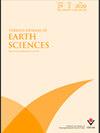Mineralogical-petrographical features, geochemical characteristics, and S isotope variability of Pb-Zn deposits in the Sakarya fragment of the Biga Peninsula (NW Türkiye)
IF 1.1
4区 地球科学
Q3 GEOSCIENCES, MULTIDISCIPLINARY
引用次数: 0
Abstract
The Biga Peninsula in northwestern Anatolia, a part of the Alpine-Himalayan orogenic belt, has a complex geology that was formed following the closure of the northern branch of the Neotethys. Intense volcanism and plutonism in the area from the Eocene to the Middle Miocene period caused several Pb-Zn-Cu±Ag±Au deposits to form. The geometry of the mineralizations is largely made up of polymetallic veins, manto-chimneys, and irregular replacement bodies. Ore-bearing and host rocks in the mineralization zones and the wall rocks outside the mineralization zones were compiled in this study. The most common minerals in the skarn zones are garnet, pyroxene, amphibole, epidote, chlorite, quartz, and calcite, while quartz, calcite, and sericite are formed in the hydrothermal alteration zones. Based on the geochemical analyses, the granitoidic rocks are granodiorite, whereas the volcanic rocks are dacite, andesite, trachyandesite, and basaltic andesite. According to the skarn-forming features, the Biga plutons have chemical characteristics that can form Pb-Zn, Cu, Fe, and Au skarns. The carbonate units in the area are made up of marble (fresh), marble (in the alteration zone), and ore calcite. The geochemical analyses of the carbonate units indicate that in composition the fresh marble is almost pure CaCO3 . However, the marble in the alteration zone has higher SiO2 , Fe2 O3 , MgO, and MnO contents than that of the fresh marble. These values are higher in ore calcite. The metasandstones mostly consist of arkose and may have contributed to the main mineralization as they have initial ore element enrichment. According to a hierarchical cluster analysis (HCA) result, three different element groups were detected, these being Sb, Rb, Zr, Ag, Y, Mo, Hg, and Nb (increased during alteration), Sr and Ba (decreasing in alteration), and Cu, Au, As, and Cd (mineralization-related). Rare earth element (REE) characteristics indicate that hydrothermal fluids, responsible for the formation of the Biga Peninsula Pb-Zn deposits, are characterized by very low REE concentrations, and consequently the origin of these fluids is predominantly meteoric. The ∑REE, (Pr/ Yb)cn, Ce/Ce* values (8.63-24.79 ppm, 2.84-8.23, 0.38-0.82, respectively) of the marble in the alteration zone and ore-bearing skarns (3.34-27.20 ppm, 2.32-5.87, 0.36-0.83) support the findings of the meteoric contribution. Based on the similarities of the general trends and the abundances of REE elements in ore-bearing skarns and wall rocks, it is thought that wall rocks may have contributed part of the lead. The δ34S isotope compositions of galena, sphalerite, pyrite, and chalcopyrite fall into a narrow range of around 0. This data indicates that the sulfur in the Pb-Zn±Cu sulfides in the Biga Peninsula is of magmatic origin (δ34Smin: -5.5, δ34Smax: 5.2, δ34Savg: -0.7; n: 40). According to the δ34S values, the mineralizations occurred under intermediate sulfidation conditions, in a reducing environment with H2 S-dominant fluids with a near neutral pH value.碧加半岛(NW trkiye)萨卡里亚碎屑铅锌矿床矿物岩相特征、地球化学特征及S同位素变异
比加半岛位于安纳托利亚西北部,是阿尔卑斯-喜马拉雅造山带的一部分,其地质构造复杂,是在新特提斯北部分支关闭后形成的。始新世至中新世中期,该区火山和深部成矿作用强烈,形成了多处Pb-Zn-Cu±Ag±Au矿床。矿化的几何形状主要由多金属脉、曼托烟囱和不规则的替代体组成。对成矿带内的含矿岩、寄主岩和成矿带外的围岩进行了整理。矽卡岩带中最常见的矿物是石榴石、辉石、角闪洞、绿帘石、绿泥石、石英和方解石,而石英、方解石和绢云母则形成于热液蚀变带。地球化学分析表明,花岗岩为花岗闪长岩,火山岩为英安岩、安山岩、粗面安山岩和玄武岩安山岩。根据矽卡岩形成特征,Biga岩体具有可形成Pb-Zn、Cu、Fe和Au矽卡岩的化学特征。区内碳酸盐单元由大理岩(新鲜)、大理岩(蚀变带)和矿石方解石组成。碳酸盐单元的地球化学分析表明,新鲜大理岩的组成几乎为纯CaCO3。蚀变带大理岩的SiO2、fe2o3、MgO和MnO含量均高于新鲜大理岩。这些值在矿石方解石中较高。变质砂岩以长石为主,具有初始的矿元素富集作用,可能对成矿作用起主要作用。根据层次聚类分析(HCA)结果,检测到3种不同的元素群,分别是Sb、Rb、Zr、Ag、Y、Mo、Hg和Nb(在蚀变过程中增加)、Sr和Ba(在蚀变过程中减少)以及Cu、Au、As和Cd(与矿化有关)。稀土元素(REE)特征表明,碧嘎半岛铅锌矿床形成的热液流体具有极低的稀土含量特征,其成因以大气流体为主。蚀变带大理岩的∑REE、(Pr/ Yb)cn、Ce/Ce*值(分别为8.63 ~ 24.79 ppm、2.84 ~ 8.23、0.38 ~ 0.82)和含矿西卡岩的∑REE、(Pr/ Yb)cn、Ce/Ce*值(3.34 ~ 27.20 ppm、2.32 ~ 5.87、0.36 ~ 0.83)均支持大气成因的发现。根据含矿矽卡岩和围岩中稀土元素的总体趋势和丰度的相似性,认为围岩可能对铅有部分贡献。方铅矿、闪锌矿、黄铁矿和黄铜矿的δ34S同位素组成在0°左右的狭窄范围内。结果表明,比加半岛Pb-Zn±Cu硫化物中的硫为岩浆成因(δ34Smin: -5.5, δ34Smax: 5.2, δ34Savg: -0.7;护士:40)。根据δ34S值,矿化发生在中等硫化条件下,以氢硫为主的还原环境中,pH值接近中性。
本文章由计算机程序翻译,如有差异,请以英文原文为准。
求助全文
约1分钟内获得全文
求助全文
来源期刊

Turkish Journal of Earth Sciences
地学-地球科学综合
CiteScore
2.40
自引率
10.00%
发文量
6
审稿时长
6 months
期刊介绍:
The Turkish Journal of Earth Sciences is published electronically 6 times a year by the Scientific and Technological Research
Council of Turkey (TÜBİTAK). It is an international English-language journal for the publication of significant original recent
research in a wide spectrum of topics in the earth sciences, such as geology, structural geology, tectonics, sedimentology,
geochemistry, geochronology, paleontology, igneous and metamorphic petrology, mineralogy, biostratigraphy, geophysics,
geomorphology, paleoecology and oceanography, and mineral deposits. Contribution is open to researchers of all nationalities.
 求助内容:
求助内容: 应助结果提醒方式:
应助结果提醒方式:


